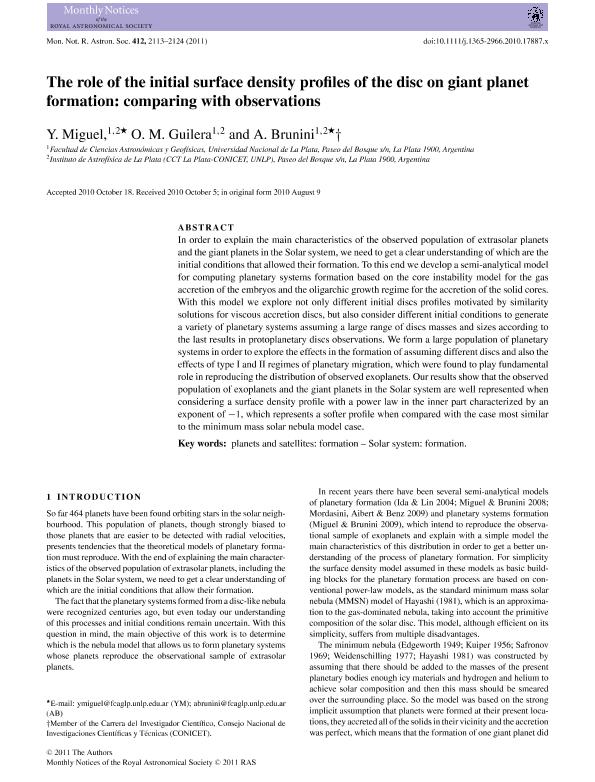Mostrar el registro sencillo del ítem
dc.contributor.author
Miguel, Yamila

dc.contributor.author
Guilera, Octavio Miguel

dc.contributor.author
Brunini, Adrian

dc.date.available
2016-12-26T14:07:22Z
dc.date.issued
2011-04
dc.identifier.citation
Miguel, Yamila; Guilera, Octavio Miguel; Brunini, Adrian; The role of the initial surface density profiles of the disc on giant planet formation: comparing with observations; Royal Astronomical Society; Monthly Notices Of The Royal Astronomical Society; 412; 4; 4-2011; 2113-2124
dc.identifier.issn
0035-8711
dc.identifier.uri
http://hdl.handle.net/11336/10061
dc.description.abstract
In order to explain the main characteristics of the observed population of extrasolar planets and the giant planets in the Solar system, we need to get a clear understanding of which are the initial conditions that allowed their formation. To this end we develop a semi-analytical model for computing planetary systems formation based on the core instability model for the gas accretion of the embryos and the oligarchic growth regime for the accretion of the solid cores. With this model we explore not only different initial discs profiles motivated by similarity solutions for viscous accretion discs, but also consider different initial conditions to generate a variety of planetary systems assuming a large range of discs masses and sizes according to the last results in protoplanetary discs observations. We form a large population of planetary systems in order to explore the effects in the formation of assuming different discs and also the effects of type I and II regimes of planetary migration, which were found to play fundamental role in reproducing the distribution of observed exoplanets. Our results show that the observed population of exoplanets and the giant planets in the Solar system are well represented when considering a surface density profile with a power law in the inner part characterized by an exponent of -1, which represents a softer profile when compared with the case most similar to the minimum mass solar nebula model case.
dc.format
application/pdf
dc.language.iso
eng
dc.publisher
Royal Astronomical Society
dc.rights
info:eu-repo/semantics/openAccess
dc.rights.uri
https://creativecommons.org/licenses/by-nc-sa/2.5/ar/
dc.subject
Planets Formation
dc.subject
Solar System Formation
dc.subject
Satellites Formation
dc.subject.classification
Astronomía

dc.subject.classification
Ciencias Físicas

dc.subject.classification
CIENCIAS NATURALES Y EXACTAS

dc.title
The role of the initial surface density profiles of the disc on giant planet formation: comparing with observations
dc.type
info:eu-repo/semantics/article
dc.type
info:ar-repo/semantics/artículo
dc.type
info:eu-repo/semantics/publishedVersion
dc.date.updated
2016-12-14T12:56:01Z
dc.journal.volume
412
dc.journal.number
4
dc.journal.pagination
2113-2124
dc.journal.pais
Reino Unido

dc.journal.ciudad
Londres
dc.description.fil
Fil: Miguel, Yamila. Universidad Nacional de la Plata. Facultad de Ciencias Astronómicas y Geofísicas; Argentina. Consejo Nacional de Investigaciones Científicas y Técnicas. Centro Científico Tecnológico La Plata. Instituto de Astrofísica de La Plata; Argentina
dc.description.fil
Fil: Guilera, Octavio Miguel. Consejo Nacional de Investigaciones Científicas y Técnicas. Centro Científico Tecnológico la Plata. Instituto de Astrofísica de la Plata; Argentina. Universidad Nacional de la Plata. Facultad de Ciencias Astronómicas y Geofísicas; Argentina
dc.description.fil
Fil: Brunini, Adrian. Consejo Nacional de Investigaciones Científicas y Técnicas. Centro Científico Tecnológico la Plata. Instituto de Astrofísica de la Plata; Argentina. Universidad Nacional de la Plata. Facultad de Ciencias Astronómicas y Geofísicas; Argentina
dc.journal.title
Monthly Notices Of The Royal Astronomical Society

dc.relation.alternativeid
info:eu-repo/semantics/altIdentifier/url/http://mnras.oxfordjournals.org/content/412/4/2113
dc.relation.alternativeid
info:eu-repo/semantics/altIdentifier/doi/http://dx.doi.org/10.1111/j.1365-2966.2010.17887.x
Archivos asociados
